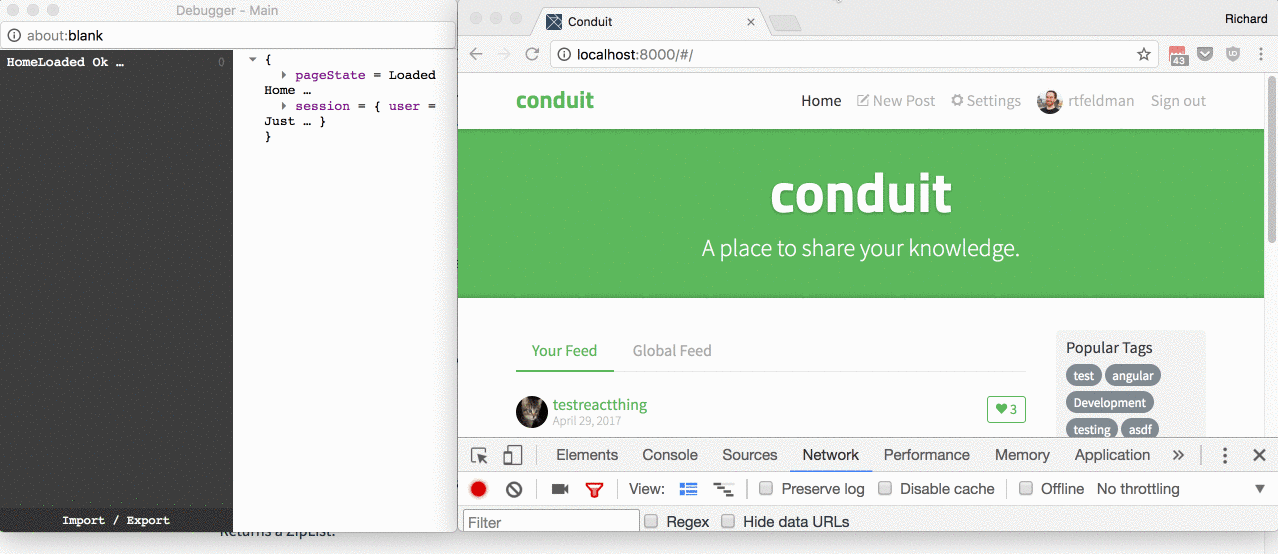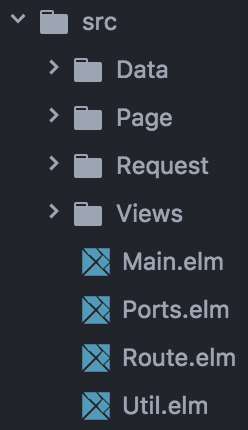Tour of an Open-Source Elm SPA
Richard Feldman
23 Jan 2019
•
6 min read
NOTE: This post was originally written in 2017. I have since updated the code for this project to Elm 0.19. See my talk at Oslo Elm Day 2019 for an explanation of what changed!
People often ask me if I can point them to an open-source Elm Single Page Application so they can peruse its code.
Ilias van Peer linked me to the Realworld project, which seemed perfect for this. They provide a back-end API, static markup, styles, and a spec, and you build a SPA front-end for it using your technology of choice.
Here's the result. I had a ton of fun building it!
4,000 lines of delicious Elm single page application goodness😋
Fair warning: This is not a gentle introduction to Elm. I built this to be something I'd like to maintain, and did not hold back. This is how I'd build this application with the full power of Elm at my fingertips.
🎥 I gave a talk at Elm Europe about the principles I used to build this, and I highly recommend watching it! It's called Scaling Elm Apps[https://www.youtube.com/watch?v=DoA4Txr4GUs].
If you're looking for a less drink-from-the-firehose introduction to Elm, I can recommend a book, a video tutorial, and of course the Official Guide.
Routing for User Experience
I went with a routing design that optimizes for user experience. I considered three use cases, illustrated in this gif:

The use cases:
- The user has a fast connection
- The user has a slow connection
- The user is offline
Fast Connection
On fast connections, I want users to transition from one page to another seamlessly, without seeing a flash of a partially-loaded page in between.
To accomplish this, I had each page expose init : Task PageLoadError Model. When the router receives a request to transition to a new
page, it doesn't transition immediately; instead, it first calls
Task.attempt on this init task to fetch the data the new page
needs.
If the task fails, the resulting PageLoadError tells the router what
error message to show the user. If the task succeeds, the resulting
Model serves as the initial model necessary to render 100% of the
new page right away.
No flash of partially-loaded page necessary!
Slow Connection
On slow connections, I want users to see a loading spinner, to reassure them that there's something happening even though it's taking a bit.
To do this, I'm rendering a loading spinner in the header as soon as
the user attempts to transition to a new page. It stays there while
the Task is in-flight, and then as soon as it resolves (either to
the new page or to an error page), the spinner goes away.
For a bit of polish, I prevented the spinner from flashing into view
on fast connections by adding a CSS
animation-delay
to the spinner's animation. This meant I could add it to the DOM as
soon as the user clicked the link to transition (and remove it again
once the destination page rendered), but the spinner would not become
visible to the user unless a few hundred milliseconds of delay had
elapsed in between.
Offline
I'd like at least some things to work while the user is offline.
I didn't go as far as to use Service Worker (or for that matter App Cache, for those of us who went down that bumpy road [https://www.youtube.com/watch?v=WqV5kqaFRDU]), but I did want users to be able to visit pages like New Post which could be loaded without fetching data from the network.
For them, init returned a Model instead of a Task PageLoadError Model. That was all it took.
Module Structure
(
We have over 100,000 lines of Elm code in production at NoRedInk, and we've learned a lot along the way! (We don't have a SPA, so our routing logic lives on the server, but the rest is the same.) Naturally every application is different, but I've been really happy with how well our code base has scaled, so I drew on our organizational scheme when building this app.
Keep in mind that although using exposing to create guarantees by
restricting what modules expose [https://youtu.be/IcgmSRJHu_8] is an
important technique (which I used often here), the actual file
structure is a lot less important. Remember, if you change your mind
and want to rename some files or shift directories around, Elm's
compiler will have your back. It'll be okay!
Here's how I organized this application's modules.
The Page.* modules
Examples: Page.Home, Page.Article, Page.Article.Editor
These modules hold the logic for the individual pages in the app.
Pages that require data from the server expose an init function,
which returns a Task responsible for loading that data. This lets
the routing system wait for a page's data to finish loading before
switching to it.
The Views.* modules
Examples: Views.Form, Views.Errors, Views.User.Follow
These modules hold reusable views which multiple Page modules import.
Some, like Views.User, are very simple. Others, like
Views.Article.Feed, are very complex. Each exposes an appropriate
API for its particular requirements.
The Views.Page module exposes a frame function which wraps each
page in a header and footer.
The Data.* modules
Examples: Data.User, Data.Article, Data.Article.Comment
These modules describe common data structures, and expose ways to
translate them into other data structures. Data.User describes a
User, as well as the encoders and decoders that serialize and
deserialize a User to and from JSON.
Identifiers such as CommentId, Username, and Slug - which are
used to uniquely identify comments, users, and articles, respectively
- are implemented as union types. If we used e.g.
type alias Username = String, we could mistakenly pass aUsernameto an API call expecting aSlug, and it would still compile. We can rule bugs like that out by implementing identifiers as union types.
The Request.* modules
Examples: Request.User, Request.Article, Request.Article.Comments
These modules expose functions to make HTTP requests to the app
server. They expose Http.Request values so that callers can combine
them together, for example on pages which need to hit multiple
endpoints to load all their data.
I don't use raw API endpoint URL strings anywhere outside these
modules. Only Request.* modules should know about actual endpoint
URLs.
The Route module
This exposes functions to translate URLs in the browser's Location bar to logical "pages" in the application, as well as functions to effect Location bar changes.
Similarly to how Request modules never expose raw API URL strings,
this module never exposes raw Location bar URL strings either. Instead
it exposes a union type called Route which callers use to specify
which page they want.
The Ports module
Centralizing all the ports in one port module makes it easier to
keep track of them. Most large applications end up with more than just
two ports, but in this application I only wanted two. See index.html
for the 10 lines of JavaScript code they connect to.
At NoRedInk our policy for both ports and flags is to use Value to
type any values coming in from JavaScript, and decode them in Elm.
This way we have full control over how to deal with any surprises in
the data. I followed that policy here.
The Main module
This kicks everything off, and calls Cmd.map and Html.map on the
various Page modules to switch between them.
Based on discussions around how asset management features like code splitting and lazy loading have been shaping up, I expect most of this file to become unnecessary in a future release of Elm.
The Util module
These are miscellaneous helpers that are used in several other modules.
It might be more honest to call this Misc.elm. 😅
Other Considerations
- With server-side rendering, it's possible to offer a better user experience on first page load by using cookie-based authentication. There are security risks on that path, though!
- If I were making this from scratch, I'd use
elm-cssto style it. However, since Realworld provided so much markup, I ended up usinghtml-to-elmto save myself a bunch of time instead. - There's a beta of
elm-testin progress, and I'd like to use the latest and greatest for tests. I debated waiting until the newelm-testlanded to publish this, but decided that even in its untested form it would be a useful resource.
I hope this has been useful to you!
And now, back to writing another chapter of Elm in Action 😉
WorksHub
Jobs
Locations
Articles
Ground Floor, Verse Building, 18 Brunswick Place, London, N1 6DZ
108 E 16th Street, New York, NY 10003
Subscribe to our newsletter
Join over 111,000 others and get access to exclusive content, job opportunities and more!

